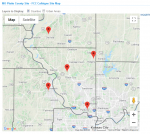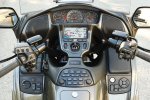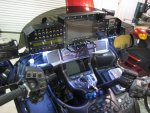SFBandman
Member
Although I have lurked here for many years I never pulled the trigger and bought a scanner. Lately, I have been reading a great deal on this forum and elsewhere on the internet. I've concluded that the SDS100 is probably my best choice but would appreciate advice and answers to a couple of questions. So...
I am in Kansas City, MO in Platte County, near the airport. My scanning desires are to listen to local law enforcement and airport communications.
I travel some, both by car and motorcycle, and would like to be able to listen to local law enforcement in other areas as I travel. Also to communications in other airports when traveling. If traveling by train I would like to be able to listen to train crews and other railroad communication. Most of which I understand to be in the 160-162Mhz range. And I understand that while not widely used some of the railroads are are dipping a toe in the NXDN world.
Kansas City is home to some NASCAR events and it might be fun to listen there as well.
Last but not least, I really only want to buy one scanner.
Because of the traveling requirement, there is no way of really knowing what frequencies I will encounter and whether they will be analog, trunked or simulcast so my conclusion was that the SDS100 was my best bet as being one radio that would accommodate all of my needs. Opinions?
However, I read on one of the railroad sites a post that claimed that the SDS100 was virtually "deaf" in the 160-162 Mhz analog range and that it was NOT suitable for monitoring railroad communications. Comments or opinions on that statement?
With regard to antennas, I have not gone very far but wonder whether to stay with the factory antenna or replace it with something else. In general, I would assume Uniden did the best they could for a general purpose antenna. However, is it possible that multiple antennas might help, e.g using the standard antenna but replace it with something else when riding on the train? If either a general or specific replacement is advisable, what is it?
Thanks in advance for your comments and help.
I am in Kansas City, MO in Platte County, near the airport. My scanning desires are to listen to local law enforcement and airport communications.
I travel some, both by car and motorcycle, and would like to be able to listen to local law enforcement in other areas as I travel. Also to communications in other airports when traveling. If traveling by train I would like to be able to listen to train crews and other railroad communication. Most of which I understand to be in the 160-162Mhz range. And I understand that while not widely used some of the railroads are are dipping a toe in the NXDN world.
Kansas City is home to some NASCAR events and it might be fun to listen there as well.
Last but not least, I really only want to buy one scanner.
Because of the traveling requirement, there is no way of really knowing what frequencies I will encounter and whether they will be analog, trunked or simulcast so my conclusion was that the SDS100 was my best bet as being one radio that would accommodate all of my needs. Opinions?
However, I read on one of the railroad sites a post that claimed that the SDS100 was virtually "deaf" in the 160-162 Mhz analog range and that it was NOT suitable for monitoring railroad communications. Comments or opinions on that statement?
With regard to antennas, I have not gone very far but wonder whether to stay with the factory antenna or replace it with something else. In general, I would assume Uniden did the best they could for a general purpose antenna. However, is it possible that multiple antennas might help, e.g using the standard antenna but replace it with something else when riding on the train? If either a general or specific replacement is advisable, what is it?
Thanks in advance for your comments and help.






